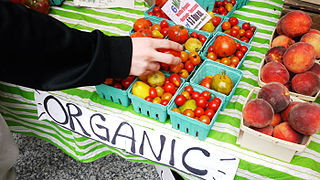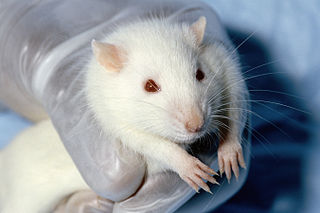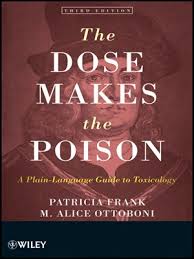Related Research Articles

A toxin is a naturally occurring organic poison produced by metabolic activities of living cells or organisms. They occur especially as proteins, often conjugated. The term was first used by organic chemist Ludwig Brieger (1849–1919) and is derived from the word "toxic".

Toxicology is a scientific discipline, overlapping with biology, chemistry, pharmacology, and medicine, that involves the study of the adverse effects of chemical substances on living organisms and the practice of diagnosing and treating exposures to toxins and toxicants. The relationship between dose and its effects on the exposed organism is of high significance in toxicology. Factors that influence chemical toxicity include the dosage, duration of exposure, route of exposure, species, age, sex, and environment. Toxicologists are experts on poisons and poisoning. There is a movement for evidence-based toxicology as part of the larger movement towards evidence-based practices. Toxicology is currently contributing to the field of cancer research, since some toxins can be used as drugs for killing tumor cells. One prime example of this is ribosome-inactivating proteins, tested in the treatment of leukemia.

Food science is the basic science and applied science of food; its scope starts at overlap with agricultural science and nutritional science and leads through the scientific aspects of food safety and food processing, informing the development of food technology.

Biochemists are scientists who are trained in biochemistry. They study chemical processes and chemical transformations in living organisms. Biochemists study DNA, proteins and cell parts. The word "biochemist" is a portmanteau of "biological chemist."

Saccharin, also called saccharine or benzosulfimide, or used in saccharin sodium or saccharin calcium forms, is a non-nutritive artificial sweetener. Saccharin is a benzoic sulfimide that is about 500 times sweeter than sucrose, but has a bitter or metallic aftertaste, especially at high concentrations. It is used to sweeten products, such as drinks, candies, baked goods, tobacco products, excipients, and for masking the bitter taste of some medicines. It appears as white crystals and is odorless.

The organic movement broadly refers to the organizations and individuals involved worldwide in the promotion of organic food and other organic products. It started during the first half of the 20th century, when modern large-scale agricultural practices began to appear.

The American Chemical Society (ACS) is a scientific society based in the United States that supports scientific inquiry in the field of chemistry. Founded in 1876 at New York University, the ACS currently has more than 155,000 members at all degree levels and in all fields of chemistry, chemical engineering, and related fields. It is one of the world's largest scientific societies by membership. The ACS is a 501(c)(3) non-profit organization and holds a congressional charter under Title 36 of the United States Code. Its headquarters are located in Washington, D.C., and it has a large concentration of staff in Columbus, Ohio.

Labcorp Drug Development is a contract research organization headquartered in Burlington, North Carolina, providing nonclinical, preclinical, clinical and commercialization services to pharmaceutical and biotechnology industries. Formerly called Covance, the company is part of Labcorp, which employs more than 70,000 people worldwide.
In the experimental (non-clinical) research arena, good laboratory practice or GLP is a quality system of management controls for research laboratories and organizations to ensure the uniformity, consistency, reliability, reproducibility, quality, and integrity of products in development for human or animal health through non-clinical safety tests; from physio-chemical properties through acute to chronic toxicity tests.

Alternatives to animal testing are the development and implementation of test methods that avoid the use of live animals.
The United States biological weapons program officially began in spring 1943 on orders from U.S. President Franklin D. Roosevelt. Research continued following World War II as the U.S. built up a large stockpile of biological agents and weapons. Over the course of its 27-year history, the program weaponized and stockpiled seven bio-agents — Bacillus anthracis (anthrax), Francisella tularensis (tularemia), Brucella spp (brucellosis), Coxiella burnetii (Q-fever), Venezuelan equine encephalitis virus, Botulinum toxin (botulism), and Staphylococcal enterotoxin B. The US also pursued basic research on many more bio-agents. Throughout its history, the U.S. bioweapons program was secret. It was later revealed that laboratory and field testing had been common. The official policy of the United States was first to deter the use of bio-weapons against U.S. forces and secondarily to retaliate if deterrence failed.

Toxicology testing, also known as safety assessment, or toxicity testing, is the process of determining the degree to which a substance of interest negatively impacts the normal biological functions of an organism, given a certain exposure duration, route of exposure, and substance concentration.

The National Institute of Molecular Biology and Biotechnology, also known as NIMBB, is a research institute of the University of the Philippines (UP). It has four branches distributed across various UP campuses, namely: UP Diliman (NIMBB-Diliman), UP Los Baños (BIOTECH-UPLB), UP Manila and UP Visayas.
Medical toxicology is a subspecialty of medicine focusing on toxicology and providing the diagnosis, management, and prevention of poisoning and other adverse effects due to medications, occupational and environmental toxicants, and biological agents. Medical toxicologists are involved in the assessment and treatment of a wide variety of problems, including acute or chronic poisoning, adverse drug reactions (ADRs), drug overdoses, envenomations, substance abuse, industrial accidents, and other chemical exposures.
Epoxidized soybean oil (ESBO) is a collection of organic compounds obtained from the epoxidation of soybean oil. It is used as a plasticizer and stabilizer in polyvinyl chloride (PVC) plastics. ESBO is a yellowish viscous liquid.
The United States Biological Defense Program—in recent years also called the National Biodefense Strategy—refers to the collective effort by all levels of government, along with private enterprise and other stakeholders, in the United States to carry out biodefense activities.
Professor Bill Harris was a genetic scientist who specialised in antibody research. An author of about 70 scientific research papers, author, editor, and contributor to many books, and 15 patent applications, Bill was most notable for his work translating science from the lab in to industry. His recent academic research centred on engineering of antibodies for application in health care, management of environmental pollution, and the derivation and use of novel combinatorial libraries. In early 2015, Bill was celebrated as a pioneering bio-entrepreneur by the University of Aberdeen during a two-day symposium at the Institute of Medical sciences.

The German Federal Institute for Risk Assessment, abbreviated BfR, is a body under public law of the German federal government with full legal capacity. The institute comes under the portfolio of the Federal Ministry of Food and Agriculture and has the task of providing scientific advice to the federal government on issues relating to food safety, product safety, chemical safety, contaminants in the food chain, animal protection and consumer health protection. Further technical supervision is performed by the Federal Ministry for the Environment, Nature Conservation, Building and Nuclear Safety and the Federal Ministry of Transport.

Wellcome Research Laboratories was a site in Beckenham, south-east London, that was a main research centre for pharmaceuticals. Until 1965, this laboratory site was situated in Kent.

The Dose That Makes the Poison: A Plain Language Guide to Toxicology is a book originally written by M. Alice Ottoboni and published in 1984 by Vincente Books to help laypeople understand what she considered to be an unfounded fear of synthetic chemicals. A second edition was published in 1991 and a third, revised by Patricia Frank, was released in 2011.
References
- ↑ Times, 22 November 1960, page 5
- ↑ "New Scientist". Reed Business Information. 23 March 1972. Retrieved 4 March 2020– via Google Books.
- ↑ Times, 9 July 1969, page 12
- ↑ "New Scientist". Reed Business Information. 8 April 1989. Retrieved 4 March 2020– via Google Books.
- ↑ "New Scientist". Reed Business Information. 11 January 1973. Retrieved 4 March 2020– via Google Books.
- ↑ "New Scientist". Reed Business Information. 18 March 1982. Retrieved 4 March 2020– via Google Books.
- ↑ "New Scientist". Reed Business Information. 23 February 1984. Retrieved 4 March 2020– via Google Books.